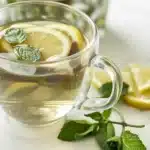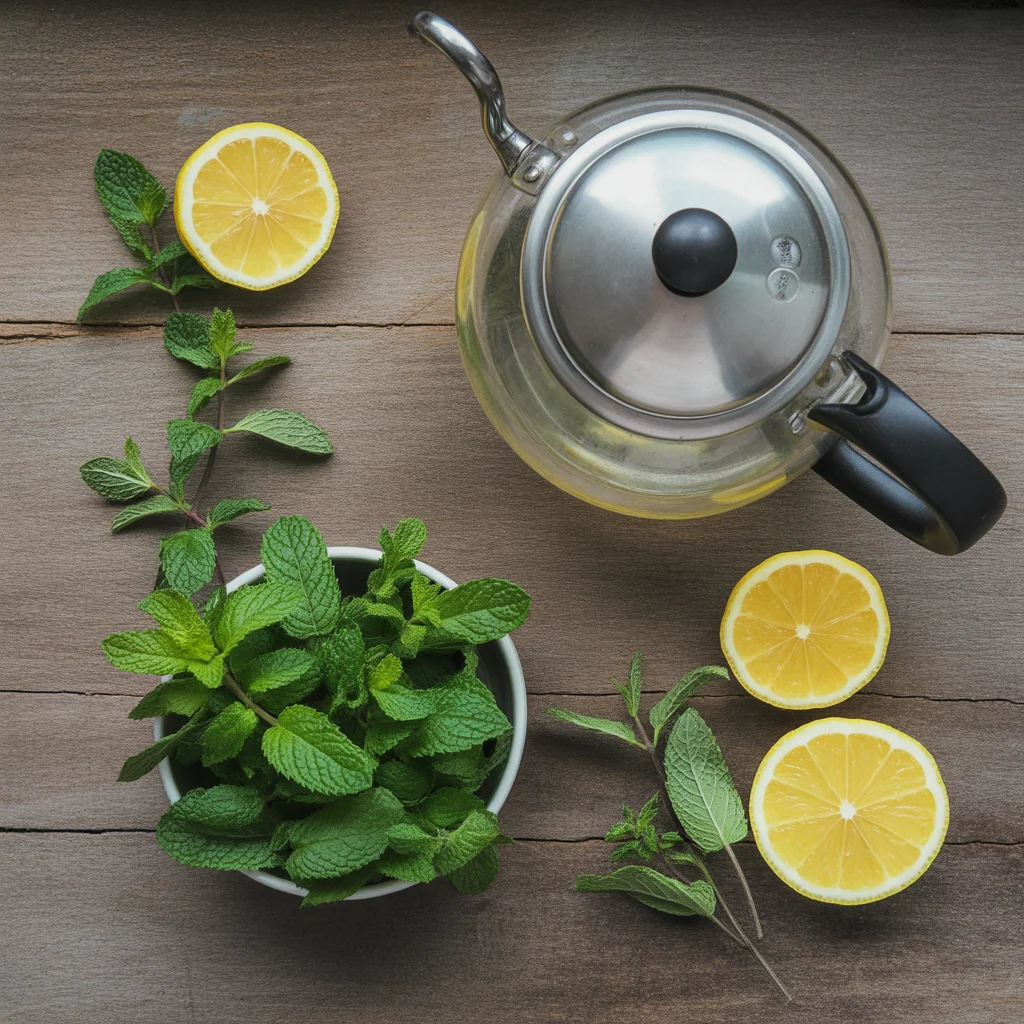Japanese lemon balm tea kind of sneaks up on you. You don’t really know it’ll help your digestion, stress, and (yep) weight loss until you’re knee-deep in stress-snacking and realize maybe a fancy energy drink isn’t the answer. I used to reach straight for coffee but trust me, winding down with this mellow, citrusy brew? Much better. I first got hooked after reading about a few classic Japanese desserts and then trying my hand at making easy yokan. Sweet treats meet herb tea? Now we’re talking!
TL;DR – Quick Takeaways
- Japanese lemon balm tea is trending in 2025 for gentle weight support, better digestion, and stress relief, all with almost no calories.
- Make 1 cup with 1 tbsp dried lemon balm, or 2 tbsp fresh, hot water, and a 5 to 7 minute steep. Optional add-ins: honey, lemon, ginger.
- For results, swap this in for sugary drinks and sip it before meals or in the afternoon to tame cravings.
- Flavor ideas: blend with matcha, or add ginger, mint, or yuzu for a bright twist.
- Storage: brewed tea keeps up to 48 hours in the fridge. Freeze leftovers as cubes for quick iced tea.
- Reminder: this is helpful, not magical. Pair with balanced eating and regular movement.
What Makes Lemon Balm Tea a Popular Natural Remedy
Lemon balm tea is like your grandma’s old medicine cabinet but in a good way. This herb’s been buzzing around kitchens in Japan (and honestly, Europe too) for centuries. People use it to chill out, settle their stomachs, and just feel better overall. There’s something gentle about it, not like those strong green teas that sometimes leave you buzzing. Plus, the soft lemony smell? It’s almost happiness in a cup. Honestly, sometimes I brew a pot just for the scent wafting through my place. Not kidding!
⚕ Quick Health Note
This recipe is for informational purposes only and isn’t medical advice. Lemon balm tea is gentle for most people, but if you’re pregnant, nursing, or taking thyroid medication, check with your healthcare provider before making it a daily habit. Always listen to your body, start with a small cup, and stay hydrated.
You might hear folks talking about “Melissa tea” (that’s the fancy botanical name), but it’s all the same plant. In Japan, it’s especially popular among people who want a gentle, no-caffeine drink that helps the body unwind. Soothing and traditional, it isn’t just hype, it’s comfort with history.
Print
Japanese Lemon Balm Tea
- Total Time: 12 minutes
- Yield: 1 cup
Description
A soothing, caffeine-free tea made from fresh lemon balm leaves that aids digestion, reduces stress, and may help with weight loss.
Ingredients
Ingredients for Japanese Lemon Balm Tea
- 1 tablespoon fresh Japanese lemon balm leaves (or 2 teaspoons dried)
- 1 cup boiling water (filtered or tap water is fine)
- Honey or agave (optional, for sweetness)
- Lemon slice (optional, for extra zing)
Instructions
Preparation
- Rinse the lemon balm leaves, especially if harvested yourself.
- Place the leaves in a mug or teapot.
- Pour boiling water over the leaves and let it steep for 5 to 7 minutes.
- Strain out the leaves.
- Optionally, add honey or a lemon slice before sipping.
Notes
Lemon balm tea is not a miracle weight loss drink but can help reduce cravings and support digestion. Experiment with variations by adding mint, ginger, or yuzu juice for different flavors. Can be enjoyed hot or iced.
- Prep Time: 5 minutes
- Cook Time: 7 minutes
- Category: Beverage, Tea
- Cuisine: Herbal, Japanese
Health Benefits of Lemon Balm for Digestion, Stress, and Weight Management
Alright, so you’re probably thinking: yeah, so it tastes nice, but does Japanese lemon balm tea actually do anything? Here’s where it gets interesting. One of my aunts swears by it for “settling the belly” after a big dinner (and we eat a lot). The herb has natural compounds that help calm your digestive system, some folks even say it soothes mild cramps or gas (I know, not glamorous but real life).
That’s not all, though. The tea brings down stress…honestly, when you’re sipping it, your shoulders just kind of drop a bit. There’s even some science behind it: lemon balm boosts something called GABA activity in the brain, helping you feel relaxed but not sluggish. And, the million-dollar part: it’s super low in calories, so when you sub this for sugary drinks, you might just see the scale nudge in the right direction. Every little bit counts, right?
“I swapped out my afternoon soda for Japanese lemon balm tea and lost five pounds in a month, plus I finally sleep like a log!” – Maya Y.
Ingredients You Need for Lemon Balm Tea
Okay, time to dive in. Here’s what you actually need:
- 1 tablespoon fresh Japanese lemon balm leaves (or 2 teaspoons dried)
- 1 cup boiling water (filtered if you can, but tap is fine too)
- Honey or agave, if you want a touch of sweetness
- Lemon slice, for a little extra zing (optional)
That’s honestly it. Not rocket science, right?
Step-by-Step Instructions to Make Lemon Balm Tea
Making Japanese lemon balm tea is so dead simple, it’s almost silly I didn’t start sooner. First, give your leaves a quick rinse, especially if you picked them yourself (I once found a tiny bug, not fun). Plunk the leaves in a mug or teapot. Next, pour boiling water over the leaves and let it sit for 5 to 7 minutes. Honestly, I usually set a timer because I get distracted scrolling Instagram.
Afterwards, just strain out the leaves. Add honey or a lemon slice if you’re feeling fancy. Sip. Relax. Repeat anytime those stress vibes creep in.
Why Lemon Balm Supports Weight Loss
Alright, let’s get real: Japanese lemon balm tea isn’t some miracle weight loss elixir, but it helps in sneaky ways. Mostly, it’s the way it settles cravings, knocks down stress eating, and cuts out hidden calories (looking at you, fancy lattes). What’s cool is it slows you down, so you’re more mindful of what you’re munching.
It also can gently boost digestion. That means less bloating and more feeling flat in your jeans. There’s no jittery caffeine spike to mess with your sleep, either, so you’re not wide-eyed at 2 am thinking about snacks. Think of it as a solid sidekick on your health journey, not a flashy main event.
Flavor Variations of Japanese Lemon Balm Tea
Honestly, you can jazz up Japanese lemon balm tea twelve ways to Sunday. Sometimes I’ll toss in a sprig of mint for coolness, or grate a little ginger for warmth when it’s freezing out. If you’re into florals, try a pinch of dried sakura petals for that “hanami picnic” vibe. You can also mix in a green tea bag for more depth, but then you’ll get a touch of caffeine.
Every now and then, I’ll add a splash of unsweetened yuzu juice for a tart kick. There are really no rules, whatever perks up your taste buds or goes with your mood. You do you.
Ideal Brewing Time and Temperature
Now, don’t just blast the leaves with boiling water and forget about it. For Japanese lemon balm tea, water right off the boil (about 200°F or 90-something °C) is best. Give it 5 to 7 minutes. That’s enough to pull out the fresh flavors without making it funky-bitter.
If you like it extra mild, go 4 minutes. Strong fan? Let it linger past 7, but be ready: it’s gonna get punchy. I’ve totally walked away and forgotten about it until lukewarm, and it’s still decent, just not as bright. Little quirks like that make brewing tea a personal thing.
How to Balance Bitterness with Natural Sweeteners
Sometimes, Japanese lemon balm tea turns a tad bitter if you steep it too long. Easy fix, stir in a tiny spoon of honey, agave, or even a bit of stevia if that’s your thing. Citrus slices (lemon or orange) also do a good trick, bringing out the mellow side of the herb. I usually skip the sugar, but if it gets too “herb-y” for your taste, sweetness will save it.
Choosing Organic vs. Conventional Lemon Balm
With Japanese lemon balm tea, organic is the way to go if you can swing it. The main reason? You’re literally steeping the leaves, you don’t want to drink weird chemicals. Organic leaves just taste fresher, at least in my kitchen they do. But hey, if all you can find is supermarket stuff, no worries! Just wash ’em thoroughly and they’ll be fine.
Buying dried leaves? Look for reputable brands or farmer’s markets. Sometimes the loose leaves look a bit brown, don’t panic, just sniff for a soft lemon scent and you’re golden.
Best Time to Drink Japanese Lemon Balm Tea for Weight Loss
Timing matters, kinda. I find sipping Japanese lemon balm tea in the late afternoon is magic for curbing snack attacks. Others swear by it half an hour before a meal; makes you less “ravenous wolf” at the dinner table. Honestly, though, it’s great anytime you need to chill out.
Just maybe not first thing if you’re a coffee-only person in the a.m. Give it a try pre-bedtime if you have a sweet tooth. Works wonders for after-dinner cravings, with practically no calories to worry about.
Serving Suggestions and Pairings
Japanese lemon balm tea pairs perfectly with light and delicate snacks! Here are some of my favorites:
- A slice of Japanese cheesecake (so fluffy, you won’t believe it’s homemade).
- A couple of dango balls (chewy, sweet, and just the right size for tea).
- Rice crackers or plain mochi keep things nice and simple.
- Fruit slices if you want to stay extra light.
Saltier snacks crank up the lemony brightness of the tea, but honestly, a good book is my usual “pairing.”
Japanese Lemon Balm Tea: Storage and Shelf Life
Fresh Japanese lemon balm leaves keep okay in the fridge, tucked in a damp paper towel and a zip bag. They’ll last a few days, sometimes up to a week if you’re lucky. Dried leaves? Store in a jar, tight lid, away from sunlight. They can hang out for several months (I’ve stretched mine to half a year before and the flavor holds up).
If you make extra tea, stash it in the fridge, good cold for about 48 hours. Never lasts that long in my house, though!
Potential Side Effects and Precautions
So, fair warning: while Japanese lemon balm tea is generally gentle, a few folks might get sleepy or feel a little too mellow from it. If you’ve got thyroid concerns (especially hypothyroidism), ask your doc before chugging a lot. Pregnant or nursing? Better bounce it off your healthcare person first.
Side effects are rare, but start slow if you’ve never tried it. The only “problem” I ever had was running out, seriously.
Nutritional Benefits of Lemon Balm Tea
The stats? Practically no calories, sugar, or fat. Japanese lemon balm tea is low-stakes sipping, but you do get a small dose of antioxidants, vitamin C, and calming rosmarinic acid. Again, don’t expect a whole salad in your cup, but for hydration and gentle support? It’s a total win.
Some studies hint it may help balance mood and might even have a small perk for blood sugar. For a basic, calming tea, that’s a nice bonus in my book.
How Does Lemon Balm Compare to Other Herbal Teas?
If you like chamomile, you’re gonna love Japanese lemon balm tea, it’s got that same calming vibe but with a lemony twist. Compared to mint or ginger, it’s way gentler and not as “in your face.” Green tea packs more antioxidants, sure, but sometimes you just need to unwind rather than get a caffeine boost.
Plus, I find Japanese lemon balm tea blends well with all sorts of other herbs if you want to experiment. It’s honestly kinda underrated compared to trendier teas out there.
Additional Ways to Use Lemon Balm in Recipes
You don’t have to stop at tea, I promise! Toss fresh lemon balm leaves in fruit salad, muddle some with sparkling water for a mocktail, or garnish desserts (looks super pretty with a slice of mochi). I even chop it into summer rolls for a citrusy lift. One friend of mine uses it in salad dressings, honestly, the options are wild.
If you want sweet treats inspiration to go along with your tea, try these classic recipes: sakura mochi you can easily make at home or the best dorayaki recipe. Pairing the tea with these desserts is low-key bliss.
Seasonal and Trend Insights
Right now, Japanese lemon balm tea is popping up everywhere, especially in Spring when fresh herbs hit the markets. More folks are looking for caffeine-free, natural drinks, so it’s not just a grandma’s thing anymore. Some trendy cafes in Tokyo serve it iced in the summer, sometimes paired with yuzu or matcha for that Instagram wow.
At home, it’s an all-year-round deal for me. Winter? Hot and soothing. Summer? Poured over ice, kinda like mini spa day in a glass.
Common Questions About Japanese Lemon Balm Tea
Well, it mostly helps you skip other high-cal drinks and calm stress-snacking. It’s not a magic bullet, but regular sipping makes a difference.
Yep! The flavor should be almost the same. Japanese lemon balm just has a tiny bit softer lemon aftertaste.
For most people, sure! If you’re pregnant, on medication, or have thyroid issues, talk to your doctor to be safe.
Absolutely! Steep it strong, chill, pour over ice. Tastes like summer sunshine.
Sweeten it up or blend with mint, green tea, or hibiscus. Play around until your taste buds are happy.
Ready for a Cozier, Healthier Routine?
There you have it..Japanese lemon balm tea is simple to make, easy to love, and actually kind to your body. It’s become my go-to for those “I need to reset” days, and you’d be surprised how much it can level out your mood or help curb snack cravings. Pair with a homemade dessert, a quiet moment, and you’ve basically got a five-star restaurant in your kitchen. For more inspiration, check out this comprehensive guide to the most trending weight loss drinks. Try it out, experiment a little, and let the relaxation commence, you won’t regret it.








